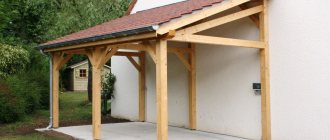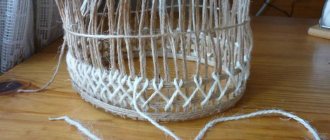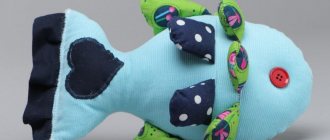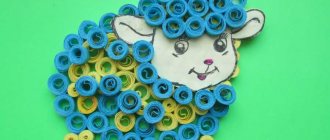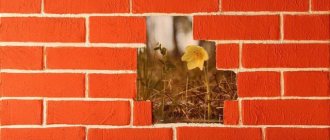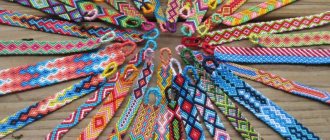What materials will you need?
Before starting work, you should look at pictures of a dog collar and choose a reference. That is, an approximate version of the product that should be obtained as a result. In some cases, you can get by with old things that have long gone out of use. You will need:
- Worn bags;
- Belts and sashes;
- Items made of dense fabrics (leather, velor, denim, bolognese, fiberglass, tapestry);
- Accessories and decorations (beads, stones, sequins, rivets);
- Reflective tape (fabric);
- Thick or thin nylon clothesline;
- Black or colored electrical tape (preferably matching the color of the future accessory);
- Strong threads, gypsy needle or awl;
- Glue “moment” or its equivalent;
- Indelible marker;
- Metal ring (diameter should be equal to the width of the collar).
Before you make a dog collar with your own hands, make sure you have all the necessary components. It is not necessary to look for all the listed items, but to make a complete and functional product you must have:
- Material for the base (canvas, fabric for a collar or rope for a noose or braided version);
- Accessories for fastening (buckle from an old belt, or fastex from an old backpack or waist bag).
- Sewing supplies.
You can also decorate the product with embroidery, applique, stripes, etc. At the same time, decoration can carry a certain functionality. For example, you can embroider the pet's name or the owner's phone number on the collar so that if the animal is lost, you can easily contact him.
For those who like to walk in the evenings, a reflective tape will be an excellent decoration, which will help you see the dog better in the dark.
How to properly walk your dog on a leash
In order not to run after the dog while walking and for both parties to enjoy the walk, you should definitely draw up a plan and exercise plan and strictly adhere to them:
- The first part of the walk should consist of natural and calm walking with the pet in the “side by side” position along the sidewalk or path in the park. At the same time, the pet learns to recognize the person as the leader in their small pack and follow him unquestioningly.
- The second stage of walking is the movement of the dog without a leash. To do this, you need to choose an area as free as possible from people and other animals, where the pet can actively run around, mark the territory and fulfill its natural needs. The owner must always be on guard, the dog must obey and return to the person unquestioningly.
- The third part of the walk is communication with other dogs. To do this, it is advisable to find a dog park and visit it every day. This is very necessary for the pet to maintain its sociality and friendliness.
- In conclusion, it is advisable to do a little training, repeat the learned commands, and continue learning new ones.
It is advisable, in order to carry out a full walk and fulfill all its goals, to have two leashes with you, for example, a tape measure and a leader or re-strap.
Reliability, functionality and safety
The primary question in the process of making ammunition for an animal is: how to sew a collar for a dog with your own hands so that it is not only beautiful, but also durable. In this case, it is important to focus on such parameters as the size, speed, character of the pet and, importantly, preferred walking areas.
So, for small dogs that are not prone to running away, a decorative collar-ornament is suitable; for pets who pull, it should be tight, well fixed with a reliable clasp. For medium-sized and giants, it is desirable to have good quality ammunition that will not let you down in any situation.
It should be taken into account that if the dog often goes to the beach and loves to swim, a leather collar will not suit him (it stretches and deteriorates from frequent exposure to water), and a metal clasp is not advisable, since after a couple of swims it will become rusty or oxidized. When the dog often walks on sand or clay soil, the accessory on the neck will be constantly smeared, grains of sand will get clogged into the porous fabric.
If your dog is friendly and likes to play with his friends, you should think about the safety of both parties. Dogs love to bite each other's necks when playing, so the ideal option would be a wide collar made of very dense material, while avoiding decorations in the form of thorns and glued-on stones.
Firstly, such details can damage your four-legged friend, and secondly, a playmate can accidentally swallow part of the decor and get health problems.
Where to start
The first thing to start with is to measure the circumference of your dog's neck. If you don’t have a meter at hand, you can use an old collar to guide you.
In order for the collar to be adjustable, be sure to add a few centimeters to the seams and fastenings.
To determine how long the sling needs to be, taking into account all the fastenings, you need to measure the circumference of the dog’s neck and multiply the resulting figure by 1.7.
For example, the circumference of my Jack's neck is 32 cm. To further adjust the collar and to take into account seam allowances, I multiplied 32 by 1.7 and got 54.4 cm. This is the length of the sling I used.
Next, you need to decide not only the length, but also the width of the nylon sling. The choice of sling will depend entirely on the size, breed and age of the four-legged animal. If you take it too thin, the collar will painfully cut into your neck. If the sling is too wide, the dog will have difficulty breathing. For puppies, a sling with a width of approximately 1.5 cm is suitable. The sizes of the materials that I used in my master class are suitable for dogs of small and medium breeds.
Comfort for you and your dog
Before choosing a specific accessory design, you should also think about how convenient it will be to use. To do this, you need to understand a few cynological tricks:
Note!
- DIY ottoman: TOP-190 photos of the best diagrams and drawings. Do-it-yourself master class with a full description of the stages of work
- Do-it-yourself easel - varieties, drawings with dimensions for creating with your own hands. Step-by-step instructions for beginners
- How to Write a Screenplay: Tips and Best Practices for Writing a Screenplay. Step-by-step master classes for beginners with detailed descriptions of the stages
- To make it easier to control the dog, the collar should be attached immediately behind the ears; the lower it slides during use, the more difficult it is for the owner;
- If your pet is pulling, you should under no circumstances lead him with a wide collar or, worse, a harness;
- If there are problems with control (the animal pulls, breaks from the leash, zoo aggression is possible), a noose collar for dogs is ideal;
- A good control should not be too soft on your pet's neck, or too wide or too narrow. (Thin choke chains are used only for canine adjustments or preparation for the ring).
Compression controls (choke, semi-choke with clamp) can be used on animals older than 8 months.
How to properly equip and train your dog using a controller
It is important to start using a leash-controller by gradually accustoming the animal to such a product. First of all, the dog needs to be taught how to put it on. It is necessary to show the pet that there is nothing scary for him
It is important to adhere to simple principles that will help you quickly accustom your animal to a new leash:
It is necessary to show the pet that there is nothing scary for him
It is important to adhere to simple principles that will help you quickly accustom your animal to a new leash: The nylon cord is laid out on the surface so that the letter “P” is formed, while the latch is located on the left side. After the device is put on the dog, you need to carefully check its tension
When used correctly, the owner's finger should fit between the collar and the dog's neck. In this case, the product is worn correctly and will not cause discomfort to the pet.
The nylon cord is laid out on the surface so that the letter “P” is formed, while the latch is located on the left side. After the device is put on the dog, you need to carefully check its tension. When used correctly, the owner's finger should fit between the collar and the dog's neck. In this case, the product is worn correctly and will not cause discomfort to the pet.
If the distance is greater, then the controller will constantly slide, which will interfere with the training process; the owner will not be able to properly control the dog’s actions. It is important that the collar is located immediately behind the pet's ears. In this case, the dog will immediately feel discomfort when the leash is pulled.
Attention! Only if the leash is used correctly does the owner have the opportunity to control a pet of any breed and weight. Training methods like these are great for young dogs who are just starting to learn. The use of a leash is only possible during training and walking.
Continuous use of the product is not recommended. If all commands are carried out correctly, the dog must be rewarded
The use of a leash is only possible during training and walking. Continuous use of the product is not recommended. If all commands are performed correctly, the dog must be rewarded.
It is necessary to put the controller on the dog correctly so as not to cause him discomfort.
If you follow all the recommendations for using the controller correctly, then after a while your furry pet will develop a certain reflex and will carry out all the necessary commands even without it.
It is important to understand that the dog should not be given unpleasant sensations, so as not to spoil the learning process.
Measuring the dog
If the collar is sewn for a puppy, it is advisable to take into account the growth factor, that is, the possibility of adjusting the strap. You need to measure the animal's neck by placing a tape measure under the jaw and placing it behind the ears, close to the body. This is the place where the collar is fixed, that is, where the buckle or parts of the flexibles meet. If a fastener is not intended, then the length should correspond to the circumference of the head (including ears).
In the case of breeds where the coverage of the neck and head is practically the same, you need to measure the dog under the front armpits (this size will allow you to attach a safety strap to the collar so that the dog does not fly out of it).
Leash training for your pet
The dog is taught to walk on a leash after it has become accustomed to the collar. When the puppy no longer pays attention to the strap around his neck, you can fasten the leash.
The collar is first put on the pet at the age of 1.5 months. At this time, kids usually joyfully perceive all innovations. But the character of puppies is different and some of them may resist and be against wearing equipment. In such a situation, the owner will have to be patient and start raising and training the dog.
Training is carried out in a calm and familiar environment for the puppy. The number of people around at this moment should be limited, the dog should be well-fed. Before you put a new accessory on your dog, you need to let him sniff it. But you should not allow your dog to play with the leash or chew on it.
Leash training a puppy
If the puppy is too active, he will be taught to use a leash after a walk, when he is slightly tired.
The training period can take from 7 to 30 days, depending on the dog’s temperament, the regularity of training and the persistence of the owner.
When teaching a puppy to a leash, adhere to the general rules of raising and training dogs:
- They always seek obedience.
- They do not start a new stage of training without completing the previous one.
- During the training process, the puppy is not punished or shouted at.
- Success is rewarded with a treat.
- The training should not be continued for longer than 15 minutes so that the baby does not get tired.
- Choose comfortable equipment: the collar should not be too tight and the leash should not be heavy.
- Accessories should not have a strong odor.
How to reward your dog with treats when training
Training is carried out with a leash no longer than 2 meters in order to be able to constantly control the dog and at the same time give it freedom. A roulette leash is not suitable for training.
In the first days, just fasten the leash to the collar, accustoming the puppy to this manipulation. The dog is then allowed to move in a limited area, but is not held on a leash. When the puppy gets used to this, his behavior begins to be controlled by the tension of the leash.
If the puppy refuses to go with the leash, you should not pull him, you should simply distract him with a toy and try again. An effective method is to encourage movement with a bowl of food.
If the dog, on the contrary, runs forward and pulls on the leash, it should be stopped. The movement continues after the ward approaches the owner.
Sew a collar
The easiest way to consider this process is step by step:
Taking into account the parameters of the dog, you need to make a cut of material (fabric). It should be equal to the width of the intended product, multiplied by 3. If the collar is 4 cm wide, the cutting width should be 12 cm. The length should also be taken with a margin, depending on the type of clasp chosen. To secure the flexiblex you need at least 2 extra cm at each end. For a mechanism with a buckle, you need to leave 2 cm to secure the plaque and a small tail with 1-2 additional holes.
The resulting cut must be folded in three widths and ironed. You will end up with one edge folded, and the other raw edge lying on top. If the fabric is not fleecy, you can leave the edge in its original form; if threads stick out from it, it is better to burn them. The folded piece of fabric must be basted along each edge, and then sewn with a stitch. After this, all that remains is to put on the flexiblex or buckle. If you need to make holes, you need to make them with a hot awl, otherwise they will quickly fray. You can decorate the product at your discretion.
Note!
- DIY medical mask: TOP-140 photos of the best DIY options. Instructions for making a mask at home
- How to make a piggy bank with your own hands - the best ways to make a piggy bank with your own hands. Detailed master class for beginners with photos and videos
- Cold porcelain: features and methods of making it at home. Reviews of the best recipes + 120 photos
It is convenient when the leash clings not to the collar, but to a special ring. You can find it on old bags, use a link from a chain, or buy it at a hardware store. At the same time, it is important to secure it so that the ring does not travel along the entire length of the collar. To do this, you need to put the ring on the collar, right in the middle. In this place, on the reverse side (which is adjacent to the animal’s body), make a patch for this ring, thus securing it completely.
Choosing the right leash
In order for walking your pet to be enjoyable for both the animal and the person, it is very important to choose the right leash.
To do this, they are guided by the following criteria:
- the size and weight of the dog;
- features of walking and types of activities during the walk;
- the original purpose of the equipment is walking, training, exhibition, competition, sports, hunting and others;
- temperament and activity of the pet;
- breed of dog - decorative, hunting, fighting.
For example, for a walk in the park, it is better to choose a roulette leash, then the animal can calmly run on a long strap, and if necessary, you can take it on a short sling.
To walk with a large dog on city streets or travel on public transport, you need to use a walker; for training and sports, there are different types of equipment, discussed in detail above.
In addition, it is important to choose the right leash size. Today accessories are available in the following sizes:
- XS – for the smallest, dwarf dog varieties;
- S – used for small pets;
- M – suitable for medium-sized dogs;
- L – these are accessories for large dogs;
- XL – leashes for especially large and giant breeds, such as chow-chow, mastiff, Moscow watchdog.
The simplest option
The easiest way to make a collar is from a belt, because the main components are already ready. However, a dog's sparse neck can rival a human's waist. All you need to do is cut the belt to the required size and make new holes. For ease of use, it is also advisable to leave clamps for the free end and make a patch for the ring, to which the leash will eventually cling.
If the edge of the belt cut is not neat, it is advisable to decorate it. This can be done by treating it with metal rivets or stitching it with leather. The easiest way is to cover it with colored tape and carefully touch it with a lighter. If the belt is made of not very high-quality leather substitute, it can be strengthened. To do this, you need to glue a thick fabric tape on the inside with waterproof (shoe) glue. This trick will not only extend the life of the collar, but also make it more comfortable to wear.
Required Tools
When the issue of manufacturing material has been decided, pet owners select tools. If you have a sewing machine at home, then the process is greatly simplified - in this case, you only need to choose the right needle and thread corresponding to its thickness.
But you can easily do it without a machine by sewing belts and connecting the parts manually. An awl often comes to the rescue here if it is difficult to pierce a canvas or leather tape with a needle. Without fasteners and double-slot buckles, a finished finished product will not work - accessories (plastic or metal) must be purchased in advance.
How to measure a dog for a collar
Wicker options
You can weave a dog collar from a number of available materials. For this you can use:
- Fabric scraps;
- Old belts;
- Clothesline or nylon rope.
In addition to the above, you will need to take care of the clasp. This can be a flexiblex or a noose-type mechanism or a semi-noose type mechanism. For a noose, 2 identical metal rings are required, for a semi noose, 3 rings and a chain.
Note!
Cake decorating: TOP-170 photos of the best ideas for decorating a cake at home + instructions for beginners with simple patterns
- How to make a house out of cardboard: 140 best photos of children's crafts with your own hands + step-by-step manufacturing instructions with simple diagrams
- DIY rose lamp - step-by-step instructions for creating a lamp with your own hands + original design ideas with photo reviews
Step-by-step weaving of a collar
- Divide the ropes into 3 parts;
- Pass each one through the ring so that 6 equal threads are formed;
- Start braiding your hair;
- When you reach the desired length, pull the ends of the ropes through the second ring in the same way;
- Carefully tie the ropes in a knot;
- Trim off the excess, leaving 3 cm for twisting;
- The remaining ends need to be hidden in the body of the pigtail and stitched with thread;
- To make a full-fledged collar, thread the pigtail through one of the rings to create a noose mechanism.
In the case of Flexex, the collar will not be adjustable. If you pass a chain through two rings and secure it with a third ring, you will get a semi-noose.
Braided collar made of quality rope
In order to weave an accessory for your pet, you must very clearly adhere to the following basic pattern:
- the rope that is needed to make the item is folded in half, pulled into a carabiner and secured with a knot;
- after the final fastening you should have four free ends of the cord;
- the carabiner must be secured to the table with tape to facilitate the weaving process;
- weaving can be done in the way that you like best. There are a lot of schemes that can be implemented in this matter;
- After the collar is ready, the free end must be burned so that the threads do not line up.
Choke collar and leash
This option will be the simplest and most cost-effective. If you have a long rope, you can make a noose leash. In essence, a noose differs from a regular loop in the presence of a lock that prevents the collar from slipping and stretching.
For production you will need:
- A rope (length depends on the desired result) for a noose collar is enough +10 cm to the circumference of the head; for a comfortable leash, 2-2.5 m is required.
- Electrical tape in the color of the rope;
- Needle and thread;
- 1 metal ring;
- 1 clamp (preferably metal).
Execution:
- Place the clamp on the rope;
- At one end, form a handle (for a leash) or a 2-3 cm loop for a carabiner in the case of a collar;
- Sew it with threads, secure with electrical tape and secure with a lighter;
- Place a ring on the other end, also sew and secure;
- Thread the rope through the ring, the resulting loop, put it on the dog’s head using a clamp to secure the position of the collar behind the ears.
Making a collar for your pet with your own hands at home from available materials is quite simple, the main thing is to show imagination and perseverance.
It is also important to understand that accessories for animals must be safe for themselves and for others, so special attention should be paid to the quality of materials and the strength of connections.
Accessories and available materials
Assembling a beautiful collar from preliminary blanks is not particularly difficult, but the selection of the necessary materials for its manufacture must be taken very seriously. Thus, you immediately need to decide on the method of manufacturing the accessory, which involves the use of different means.
Weaving collars:
- a rope or cord, the length of which is at least four meters and the width of three millimeters. The material used to make it is mostly leather, nylon or silk;
- carabiner for collar fastening;
- the ring is not very large in diameter;
- scotch;
- matches.
If you decide to sew a collar:
- sling made of material such as nylon;
- material tape;
- a plastic fastener so that you can fasten your product together;
- D-ring;
- thread;
- a buckle that has two entrances so that the length of the item can be effectively adjusted.
In addition to thread specimens, you can weave collars for pet dogs from rubber bands, which will also look very impressive and be highly durable. An elastic band for this purpose is also selected exclusively that will not cause allergic reactions and will serve for a very long time.
What you need to make a leather collar:
- a belt that is no longer needed or another piece of leather material;
- a very sharp small knife (preferably if it is specially designed for processing leather);
- half type ring;
- buckle;
- decorations.
Thus, how to properly make a high-quality collar largely depends on the professionalism of the master, as well as on what kind of material is used for this purpose.



